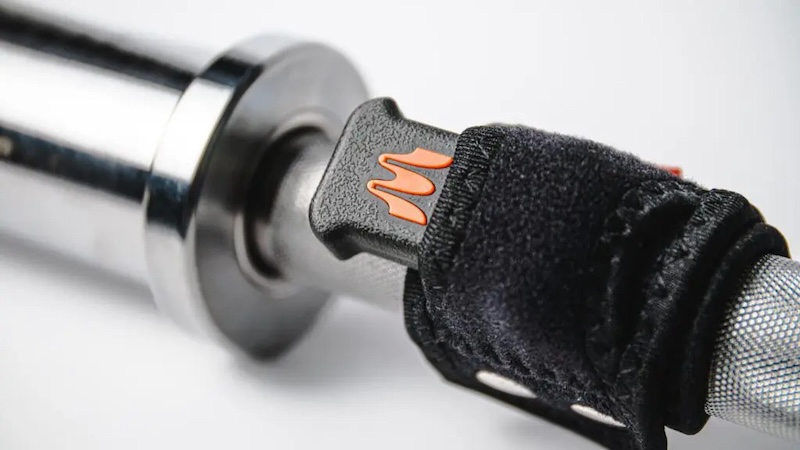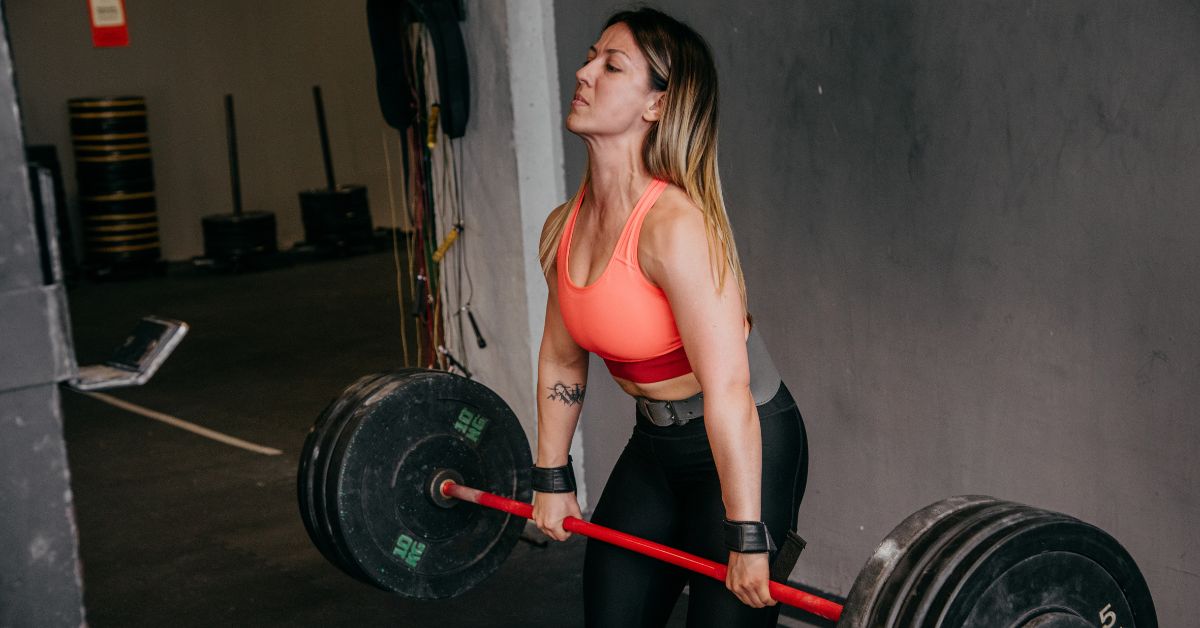If you know what velocity-based training is, you’ll want a closer look at its zones and charts to effectively use it either for yourself or with your athletes.
We’re going to jump right into it, giving you all the details on the VBT chart and zones, their benefits, and the equipment needed for velocity-based training.
Velocity-Based Training Chart
The velocity-based training chart categorizes different training zones based on the speed an athlete performs a specific movement—like the bench press, squat, clean, etc.
The VBT chart includes different velocity ranges, each matched up to different training outcomes.

That means us coaches can build training programs for our athletes to meet specific performance goals, whether it’s building strength, power, or endurance.
For example:
- Strength Zone: This zone focuses on maximal strength development and usually involves moving weight at slower velocities (e.g. 0.15-0.5 m/s).
- Power Zone: Aimed at increasing explosive power, the power zone involves moderate velocities (e.g. 0.75-1.00 m/s).
- Speed Zone: This zone targets speed and agility, involving higher velocities (e.g. 1.00-1.50 m/s).
Understanding these different zones and their associated velocity ranges allows for more precise and effective training programs that ultimately lead to better athletic performance.
It’s also great for measuring fatigue and readiness to train, helping prevent injuries—especially during the on-season when fatigue builds up more.
The VBT Zones
Velocity-based training is divided into several zones, each designed to target specific aspects of athletic performance.
This can be very useful for different types of strength training, speed training, power training, etc.
Let’s take a closer look at these zones:
Absolute Strength
Absolute strength is the maximum amount of force that an athlete can produce, regardless of time.
Training in this zone focuses on lifting heavy loads at slower velocities.
Velocity Metrics
- Velocity Range: 15 – 0.5 m/s
- Load: 85-100% of 1RM
Training Tips
- Focus on Form: Maintain proper technique while lifting heavy loads.
- Long Rest Periods: Use longer rest periods—around 3-5 minutes—to fully recover between sets.
Accelerative Strength
Accelerative strength is all about producing high levels of force in a short period of time.
This bridges the gap between absolute strength and speed, emphasizing the ability to accelerate a load quickly, which has strong carryover to many sports.
Velocity Metrics
- Velocity Range: 5 – 0.75 m/s
- Load: 70-85% of 1RM
Training Tips
- Explosive Movements: Focus on lifting the weight as quickly as possible.
- Moderate Rest Periods: Rest for 2-3 minutes between sets to maintain a high power output.
Strength Speed
Strength speed is all about lifting moderately heavy loads at higher velocities.
This VBT zone is especially important for athletes who need to develop both strength and speed at the same time—we’re all for efficiency in movement and training!
Velocity Metrics
- Velocity Range: 75 – 1.0 m/s
- Load: 50-70% of 1RM
Training Tips
- Dynamic Exercises: Do exercises like power cleans, snatches, and jump squats.
- Focus on Speed: Move the weight quickly while maintaining control.
Speed Strength
Speed strength focuses on moving lighter loads at very high velocities.
This is definitely one to focus on for developing the ability to exert force rapidly (and is one of my personal favorites).
Velocity Metrics
- Velocity Range: 0 – 1.3 m/s
- Load: 30-50% of 1RM
Training Tips
- Plyometrics: Include plyometric exercises like box jumps, depth jumps, and medicine ball throws.
- Short Rest Periods: Rest for 1-2 minutes to maintain high intensity and speed.
Starting Strength
Starting strength is the ability to generate force from a stationary position—AKA from starting blocks, the beginning of an Olympic lift, powerlifting, etc.
The focus here is on the initial phase of movement, which isn’t just important for something like deadlifts, but also for sports that involve quick starts and changes in direction like hockey, basketball, etc.
Velocity Metrics
- Velocity Range: 3 – 1.5+ m/s
- Load: 0-30% of 1RM
Training Tips
- Starting Drills: Include drills like sled pushes, resisted sprints, and banded jumps.
- High Velocity: Focus on maximal speed and quickness in each movement.
Why Use Velocity-Based Training Zones?
Velocity-based training zones offer several advantages that can seriously up your athletic performance.
Here are some of my favorite benefits:
Precision & Individualization
One of the biggest advantages of VBT is its ability to provide precise and individualized training.
Or rather, it allows us as coaches to create those individualized training programs based on VBT zones and metrics, letting us target the specific needs and goals of each athlete.
Objective Feedback
VBT provides real-time, objective feedback on an athlete’s performance.
This allows for immediate adjustments, ensuring that each training session is actually in the zone we’re trying to target rather than guessing.
Also, athletes can see their progress in real-time, which can be incredibly motivating and helpful.
Injury Prevention
VBT zones can help prevent overtraining and reduce the risk of injury by monitoring how well an athlete is performing during that training session.
Coaches can identify when an athlete is fatigued or at risk of injury and adjust the training load as needed, changing the VBT zone to something more manageable for the athlete.
Plus, targeting different training zones allows coaches to collect data on how often an athlete is training in a specific zone, further helping prevent overtraining.
Enhanced Performance
Ultimately, the goal of any training program is to improve performance.
Athletes can reach their performance goals more efficiently by training in the right velocity zones, taking the guess-work out of the equation.
Equipment for VBT Training
You’ll need the right equipment to properly use velocity-based training charts and zones.
At SimpliFaster, we offer a range of tools specifically to help coaches and athletes get the most out of their VBT programs.
One such tool is the Enode Sensor.
Enode Sensor
The Enode Sensor is a state-of-the-art device that provides real-time data on movement velocity.

It’s small, light, incredibly accurate, and easy to use, making it a powerful tool for any VBT program.
Here are some of its features:
- Real-Time Feedback: The Enode Sensor gives instant feedback on movement velocities, allowing you to make immediate adjustments.
- User-Friendly Interface: The Enode Sensor is designed with ease-of-use in mind, featuring a simple interface and easy attachment options that can be integrated into nearly any training program.
- Durability: The Enode Sensor is both durable and reliable, keeping up with intense training sessions.
- Compatibility: You can use it with a wide range of different types of exercises and equipment.
Conclusion
Velocity-based training is a great method for improving athletic performance.
Coaches and athletes can create highly effective and individualized training programs by understanding and using the VBT chart and zones, making sure all training is optimized, safe, and intentional towards a goal.
Whether you’re a coach, trainer, or athlete, our range of products, including the Enode Sensor, can help you take your performance to the next level.
FAQs
How do velocity zones work in VBT?
Velocity zones in VBT categorize the speed of movement into different ranges, each corresponding to specific training adaptations.
How can I incorporate VBT into my existing training program?
Start by identifying your target velocity zones based on your training goals. Use a VBT device to measure movement velocity during exercises. Adjust your loads accordingly to stay within the desired velocity ranges, and consistently monitor and record your performance to track progress and make necessary adjustments.
What are the benefits of using VBT charts and zones in training?
Using VBT charts and zones provides several advantages like personalized and optimized training, easier performance targeting, injury prevention, and immediate feedback.






